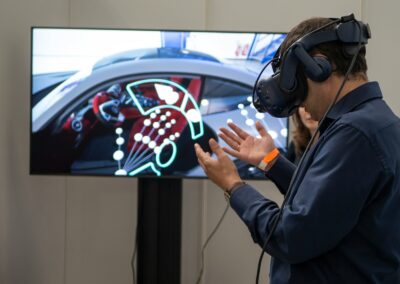Crafting Immersive Narratives: Insights from “A Fisherman’s Tale”
Unveiling the Art of VR Storytelling
When it comes to storytelling techniques in VR, “A Fisherman’s Tale” stands as a remarkable example of how virtual reality can transform traditional narrative forms into immersive experiences. The game employs several innovative techniques to engage players and deliver a story that is both mind-bending and emotionally resonant. Understanding these techniques is crucial for business executives, mid-level managers, and entrepreneurs interested in harnessing VR for storytelling and brand experiences.
At the core of “A Fisherman’s Tale” is the use of spatial storytelling. Unlike traditional media, VR allows for a 360-degree environment where the narrative unfolds around the user. This spatial approach immerses players in the story, making them an integral part of the narrative rather than passive observers. In the game, players interact with their surroundings and uncover story elements through exploration. This method not only enhances engagement but also ensures that the story feels personal and immediate.
Another notable technique used in the game is perspective manipulation. “A Fisherman’s Tale” plays with the player’s perception by shifting viewpoints and employing optical illusions. For instance, the game utilizes forced perspective and scale manipulation to create surprising and thought-provoking experiences. This technique challenges the player’s understanding of the environment and narrative, making the VR experience both captivating and intellectually stimulating.
Creating Immersive Experiences through Interactive Design
The interactive design of “A Fisherman’s Tale” is another key element that contributes to its immersive storytelling. The game incorporates interactive elements that allow players to influence the story and explore different outcomes. This level of interactivity not only deepens engagement but also empowers players to shape their own narrative experience. By interacting with objects and making choices, players become co-creators of the story, adding a layer of personalization that enhances the overall experience.
Moreover, the use of environmental storytelling in “A Fisherman’s Tale” plays a significant role in immersing players in the VR world. The game’s environment is meticulously crafted to convey narrative information through visual and auditory cues. Players can glean details about the story and characters by observing their surroundings and listening to environmental sounds. This method of storytelling seamlessly integrates the narrative into the gameplay, making the experience more cohesive and engaging.
In addition, the game employs emotional engagement techniques to connect with players on a deeper level. Through character development, immersive environments, and compelling audio design, “A Fisherman’s Tale” evokes a range of emotions, from curiosity and wonder to empathy and introspection. This emotional connection enhances the overall impact of the story and leaves a lasting impression on players.
Leveraging VR Storytelling for Business and Innovation
Understanding and applying storytelling techniques in VR can provide valuable insights for business executives and entrepreneurs looking to leverage VR for brand storytelling and marketing. By incorporating spatial storytelling, perspective manipulation, and interactive design into their VR experiences, businesses can create compelling narratives that captivate and engage their audiences.
In the context of modern technology and business success, VR storytelling offers a unique opportunity to differentiate brands and create memorable experiences. For example, companies in Saudi Arabia, the UAE, and other tech-forward regions can utilize VR storytelling to showcase their products or services in innovative ways. By creating immersive and interactive experiences, businesses can enhance brand engagement, build stronger connections with their audiences, and stand out in a competitive market.
Furthermore, the insights gained from “A Fisherman’s Tale” can inform executive coaching services and leadership development programs. By exploring how immersive storytelling can drive engagement and emotional connection, leaders can apply these principles to their own communication and management strategies. This approach can foster more effective leadership, improve team dynamics, and enhance overall organizational performance.
Conclusion
In the realm of storytelling techniques in VR, “A Fisherman’s Tale” exemplifies how virtual reality can transform narrative experiences into immersive and engaging journeys. By leveraging spatial storytelling, perspective manipulation, interactive design, and emotional engagement, the game creates a unique and impactful experience for players.
For business executives, entrepreneurs, and leaders, understanding these techniques offers valuable insights into how VR can be used to enhance brand storytelling, marketing strategies, and leadership development. As VR technology continues to evolve, embracing innovative storytelling approaches will be crucial for creating compelling experiences that resonate with audiences and drive business success.
#StorytellingTechniquesInVR #AFishermansTale #ImmersiveVRExperience #VRNarrativeDesign #VRStorytelling #SaudiArabia #UAE #AIinVR #ModernTech #LeadershipinTech #GenerativeAI #Metaverse























